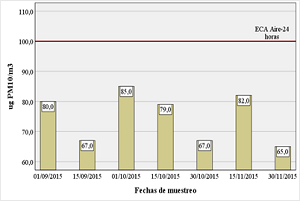Urban air pollution level by respirable suspend particles (PM-10 and PM-2.5)
DOI:
https://doi.org/10.51252/reacae.v1i2.373Keywords:
air, quality, particulate matter PM-10, particulate matter PM-2.5Abstract
The populations are daily exposed to breathable suspended particles that turn out to be a problem in all the cities of the planet, putting at risk the quality of the air and the health of the human being, it is in response to this that the present study was developed in the area of the river basin Alto Mayo, which includes the towns of Naranjos, Nueva Cajamarca, Segunda Jerusalem, Rioja and Moyobamba, places where the monitoring was carried out. The determination of the concentration of breathable suspended particles smaller than 10 microns (PM-10) and smaller than 2.5 microns (PM-2.5) was considered as objectives. The methodology used to determine the concentrations was by gravimetric method, from which it was obtained that during the sampling period (4 months), at all points the value obtained for PM-10 does not exceed the Environmental Quality Standard (ECA). ) for 24 hours of 100 uց/m3; however, the towns of Nueva Cajamarca and Moyobamba have the highest values, likewise, at all sampling points the value obtained for PM-2.5 does not exceed the ECA for 24 hours of 50 u/m3, with the towns of Nueva Cajamarca and Moyobamba who present the highest values.
Downloads
References
Adar, S. D., Filigrana, P. A., Clements, N., & Peel, J. L. (2014). Ambient Coarse Particulate Matter and Human Health: A Systematic Review and Meta-Analysis. Current Environmental Health Reports, 1, 258-274. https://doi.org/10.1007/S40572-014-0022-Z
EPA. (2022, mayo 23). Efectos del material particulado (PM) sobre la salud y el medioambiente | US EPA. Efectos sobre el medioambiente. https://espanol.epa.gov/espanol/efectos-del-material-particulado-pm-sobre-la-salud-y-el-medioambiente
Fang, G. C., Chang, C. N., Chu, C. C., Wu, Y. S., Fu, P. P. C., Yang, I. L., & Chen, M. H. (2003). Characterization of particulate, metallic elements of TSP, PM2.5 and PM2.5-10 aerosols at a farm sampling site in Taiwan, Taichung. Science of the Total Environment, 308(1-3), 157-166. https://doi.org/10.1016/S0048-9697(02)00648-4
Feng, C., Li, J., Sun, W., Zhang, Y., & Wang, Q. (2016). Impact of ambient fine particulate matter (PM2.5) exposure on the risk of influenza-like-illness: A time-series analysis in Beijing, China. Environmental Health: A Global Access Science Source, 15(17), 1-12. https://doi.org/10.1186/S12940-016-0115-2/FIGURES/6
Ilizarbe-Gonzáles, G. M., Valdiviezo, L. G. ., Rojas Quincho, J. P. ., Cabello Torres, R. J. ., & Ugarte Alvan, C. A. (2020). Chemical Characteristics and Identification of PM10 Sources in Two Lima Districts, Peru. DYNA, 87(215), 57-65. https://doi.org/10.15446/dyna.v87n215.83688
Jaenicke, R. (2001). Ernö Mészáros: Fundamentals of Atmospheric Aerosol Chemistry. Journal of Atmospheric Chemistry, 39, 99-103. https://doi.org/10.1023/A:1010753724116
Kobza, J., Geremek, M., & Dul, L. (2018). Characteristics of air quality and sources affecting high levels of PM10 and PM2.5 in Poland, Upper Silesia urban area. Environmental Monitoring and Assessment, 190(9), 515. https://doi.org/10.1007/s10661-018-6797-x
Linares, C., & Díaz, J. (2009). Efecto de las partículas de diámetro inferior a 2,5 micras (PM2,5) sobre los ingresos hospitalarios en niños menores de 10 años en Madrid. Gaceta Sanitaria, 23(3), 192-197. https://doi.org/10.1016/J.GACETA.2008.04.006
OECD. (2001, septiembre). Suspended particulate matter (SPM). https://stats.oecd.org/glossary/detail.asp?ID=2623
Pacsi Valdivia, S. A. (2016). Análisis temporal y espacial de la calidad del aire determinado por material particulado pm10 y pm2,5 en lima metropolitana. Anales Científicos, 77(2), 273. https://doi.org/10.21704/ac.v77i2.699
Samoli, E., Analitis, A., Touloumi, G., Schwartz, J., Anderson, H. R., Sunyer, J., Bisanti, L., Zmirou, D., Vonk, J. M., Pekkanen, J., Goodman, P., Paldy, A., Schindler, C., & Katsouyanni, K. (2005). Estimating the Exposure–Response Relationships between Particulate Matter and Mortality within the APHEA Multicity Project. Environmental Health Perspectives, 113(1), e7387. https://doi.org/10.1289/EHP.7387
Sanchez, C. (2011). Clasificación del material particulado menor de 10 micrometros PM10. https://www.valladolid.es/es/rccava/contaminantes/material-particulado-pm10-pm2-5
Saxena, P., & Sonwani, S. (2019). Primary Criteria Air Pollutants: Environmental Health Effects. Criteria Air Pollutants and their Impact on Environmental Health, 49-82. https://doi.org/10.1007/978-981-13-9992-3_3
Suárez-Salas, L., Álvarez Tolentino, D., Bendezú, Y., & Pomalaya, J. (2017). Caracterización química del material particulado atmosferico el centro urbando de huancayo, Perú. Revista de la Sociedad Química del Perú, 83(2), 187-199. https://doi.org/10.37761/RSQP.V83I2.197
Wark, K., & Warner, C. (2012). Contaminación del aire: Origen y ontrol (1a edición). Limusa: Noriega. https://www.biblioteca.une.edu.pe/cgi-bin/koha/opac-detail.pl?biblionumber=61198&query_desc=pb%3ALimusa%3ANoriega
WHO. (2013). - Review of evidence on health aspects of air pollution - REVIHAAP Project, Technical Report. World Health Organization, Regional Office for Europe, Copenhagen, Denmark. https://www.eea.europa.eu/data-and-maps/indicators/exceedance-of-air-quality-limit-3/who-2013

Published
How to Cite
Issue
Section
License
Copyright (c) 2022 Alfonso Rojas-Bardález, Miguel Guerra-Saldaña

This work is licensed under a Creative Commons Attribution 4.0 International License.
The authors retain their rights:
a. The authors retain their trademark and patent rights, as well as any process or procedure described in the article.
b. The authors retain the right to share, copy, distribute, execute and publicly communicate the article published in the Revista Amazónica de Ciencias Ambientales y Ecológicas (REACAE) (for example, place it in an institutional repository or publish it in a book), with an acknowledgment of its initial publication in the REACAE.
c. Authors retain the right to make a subsequent publication of their work, to use the article or any part of it (for example: a compilation of their works, notes for conferences, thesis, or for a book), provided that they indicate the source of publication (authors of the work, journal, volume, number and date).



